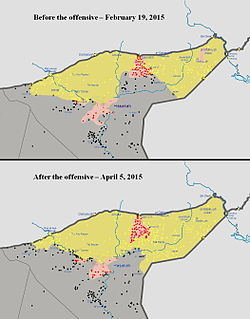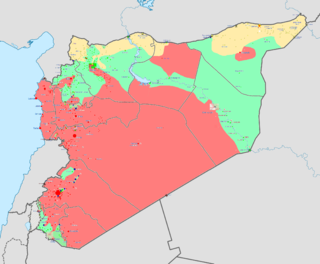
The Battle of Ras al-Ayn was a series of armed clashes for control of the town of Ras al-Ayn during the Syrian Civil War, mainly between the Kurdish-majority People's Protection Units (YPG) and an alliance of Syrian rebel groups, with the occasional involvement of the Syrian Armed Forces. As result of the battle's first phase, the Syrian Army was expelled from the city by Syrian rebels, whereupon the latter attacked the YPG-affiliated fighters in Ras al-Ayn. In the following months, the city was effectively divided into rebel-held and YPG-held areas, with intermittent fighting resulting in the gradual expansion of the YPG's territory in the city and its surroundings. Islamist and jihadist factions soon became dominant among the rebels in the region, further contributing to tensions with the secular-leftist YPG. In July 2013, the battle's final phase erupted and ended when an alliance of YPG-led troops completely expelled the rebels from Ras al-Ayn.

The Syriac Military Council is an Assyrian/Syriac military organisation in Syria, part of the Syrian Democratic Forces. The establishment of the organisation was announced on 8 January 2013. According to the Syriac Military Council, the goal of the organisation is to stand up for the national rights of and to protect Assyrians in Syria. It operates mostly in the densely populated Assyrian areas of Al-Hasakah Governorate, and is affiliated to the Syriac Union Party.

The Ahfad al-Rasul Brigades was a Syrian rebel group fighting against the Syrian government in the Syrian Civil War. It was funded by the Qatari government.

The Rojava–Islamist conflict, a major theater in the Syrian civil war, started after fighting erupted between the Kurdish People's Protection Units (YPG) and Islamist rebel factions in the city of Ras al-Ayn. Kurdish forces launched a campaign in an attempt to take control of the Islamist-controlled areas in the governorate of al-Hasakah and some parts of Raqqa and Aleppo governorates after al-Qaeda in Syria used those areas to attack the YPG. The Kurdish groups and their allies' goal was also to capture Kurdish areas from the Arab Islamist rebels and strengthen the autonomy of the region of Rojava. The Syrian Democratic Forces would go on to take substantial territory from Islamist groups, in particular the Islamic State of Iraq and the Levant, provoking Turkish involvement in the Syrian Civil War.

Liwa Thuwar al-Raqqa was a rebel group in the Syrian Civil War. It was formed in September 2012 in the Raqqa Governorate. Aligned with jihadist factions for its first years, at the end of 2015, it joined the Syrian Democratic Forces. During an interview by Aymenn Jawad Al-Tamimi in 2015, Liwa Thuwar al-Raqqa's media director stated that the group wants a "civil democratic state". He also claimed that the group had no relations with the Syrian National Coalition based in Turkey.

The Eastern al-Hasakah offensive was launched in the Al-Hasakah Governorate during the Syrian Civil War, by the Kurdish-majority People's Protection Units, Assyrian Christian militias, and allied Arab forces against the jihadist Islamic State of Iraq and the Levant, with the intent of retaking the areas of the Jazira Canton that had been captured by ISIL. Subsequently, the Syrian Armed Forces also launched an assault against the jihadists, without coordinating with the YPG.
Al-Yaarubiyah is a town in al-Hasakah Governorate, Syria. According to the Syria Central Bureau of Statistics (CBS), Al-Yaarubiyah had a population of 6,066 in the 2004 census. It is the administrative center of a nahiyah ("subdistrict") consisting of 62 localities with a combined population of 39,459 in 2004.

The Western al-Hasakah offensive, dubbed Operation Commander Rûbar Qamishlo by the Kurds, was a military operation during May 2015 in the Al-Hasakah Governorate, during the Syrian Civil War, conducted by Kurdish YPG and allied forces against the Islamic State of Iraq and the Levant. On 31 May 2015, as most of the offensive operations in the western Al-Hasakah Governorate ended, the part of the offensive in the Ras al-Ayn District expanded into the Tell Abyad region, in the northern Raqqa Governorate.

The Tell Abyad offensive or Martyr Rubar Qamışlo operation was a military operation that began in late May 2015 in the northern Raqqa Governorate, during the Syrian Civil War. It was conducted by the Kurdish-majority People's Protection Units (YPG) and the Free Syrian Army (FSA) against the Islamic State of Iraq and the Levant. The offensive took place from the end of May until July 2015. The campaign was the second phase of the Kurdish Operation Commander Rûbar Qamishlo, which began with the Al-Hasakah offensive, and involved the merger of the Kobanî offensive with the former. The focus of the campaign was to capture the key border town of Tell Abyad, and to link the Kobanî and Jazira Cantons in Northern Syria.
The following is a timeline of the Syrian Civil War from January to July 2015. Information about aggregated casualty counts is found at Casualties of the Syrian Civil War.
Relations between the People's Protection Units (YPG) and the Free Syrian Army (FSA) are unclear and varied among the different FSA factions. Both are opposed to the Islamic State of Iraq and the Levant. However, several clashes have taken place. Under pressure from the United States, some FSA groups coordinate with the YPG to battle ISIL under the name of the Syrian Democratic Forces, although some other FSA groups remained in conflict with the YPG and the SDF, including FSA groups in the SDF.

The Forces of the Brave, generally called the al-Sanadid Forces, are a militia formed by the Arab Shammar tribe to fight against the Islamic State. Even though the tribe's Syrian strongholds are mostly in the Jazira Canton of Rojava, such as at al-Yaarubiyah and Tell Hamis, the militia operates throughout most of Rojava. The red colour in their flag represents blood while the yellow represents the light, calling themselves “marchers on the red death”. The al-Sanadid Forces are affiliated with the co-governor/co-president of Jazira Canton and tribal leader Humaydi Daham al-Hadi, and are led by Humaydi's son Bandar al-Humaydi.

The 2013 battle of Tell Abyad was a military confrontation in the town of Tell Abyad between the Kurdish Front and the Democratic Union Party-affiliated People's Protection Units and Women's Protection Units against the Islamic State of Iraq and the Levant, the al-Nusra Front, and Ahrar al-Sham, resulting in a Kurdish defeat and the jihadist capture of the town.

The Battle of al-Yaarubiyah was fought in late October 2013 at al-Yaarubiyah, a strategically important town at the border of Syria with Iraq. Affiliates of the Democratic Union Party (PYD), namely the YPG/YPJ and local Arab tribes, attacked the settlement in an attempt to capture it from Jihadist and Islamist groups, led by the Al-Nusra Front and the Islamic State of Iraq and the Levant. After four days of heavy fighting, the Islamists were defeated and expelled from al-Yaarubiyah.

The al-Hasakah Governorate campaign was a multi-sided military conflict between Syrian government forces, Kurdish forces, armed Syrian opposition groups, and Salafist jihadist forces, including al-Qaeda's Islamic State of Iraq and the Levant and the al-Nusra Front in the al-Hasakah Governorate as part of the Syrian Civil War. The clashes began with the People's Protection Units (YPG)'s entrance into the civil war in July 2012 and spread across the governorate.

The Northern Democratic Brigade is a Free Syrian Army unit that is closely allied to the Syrian Kurdish YPG and YPJ in Afrin Region since 2014. Led by Absi Taha, Alexander Khalil, and Alexander Alaa, it also joined the Syrian Democratic Forces (SDF) in November 2015. The initial members of the group originated from Jabal Zawiya in Idlib, and it has recruited Arabs from Idlib, Aleppo, and other cities in northern Syria since allying with the YPG. Since joining the SDF, the unit has begun to operate across much of northern and eastern Syria, participating in operations against anti-SDF Syrian opposition factions, the Islamic State of Iraq and the Levant, the Turkish Armed Forces, and the Syrian National Army.

Tajammu Ahrar al-Sharqiya, commonly referred to as Ahrar al-Sharqiya, is an active armed Syrian rebel group founded in 2016 by individuals exiled and displaced mostly from the Deir ez-Zor Governorate and other eastern provinces, such as the Hasakah Governorate, by ISIL, YPG and the Syrian government due to fighting that took place there between 2011 and 2014. Many fighters in Ahrar al-Sharqiya are former al-Nusra and Ahrar al-Sham members. It is accused of integrating many former ISIS members into its ranks.

The Conquest Brigade, also known as Battalion of Conquest or al-Fatah Brigade, is a Sunni Islamist Free Syrian Army group that takes part in the Syrian Civil War. One of the largest rebel factions active in Aleppo Governorate during the early civil war, the militia played a major part in the fighting for Aleppo city and other battles. As result of conflicts with government forces, the Islamic State of Iraq and the Levant, and the Syrian Democratic Forces, it declined after 2013. The Conquest Brigade became part of the Turkish-backed Free Syrian Army (TFSA) in 2016.

Osama Suleiman Mansour Hilali is a member of the Kurdish Future Movement in Syria. A Mhallami from Qamishli, he was also an activist who led protests during the Syrian uprising in 2011, and a militant who founded the Mashaal Brigade, an armed rebel group that consisted of both Kurds and Arabs. Under Hilali's command, the group fought against Syrian government forces and the mainly-Kurdish People's Protection Units (YPG) between 2012 and 2013, during the Syrian Civil War, most notably in the Battle of Ras al-Ayn.
Opposition–ISIL conflict during the Syrian Civil War started after fighting erupted between Syrian opposition groups and the Islamic State of Iraq and the Levant (ISIL). In early January 2014, serious clashes between the groups erupted in the north of the country. Opposition groups near Aleppo attacked ISIL in two areas, Atarib and Anadan, which were both strongholds of the fundamentalist Sunni organization. Despite the conflict between ISIL and other rebels, one faction of ISIL has cooperated with the al-Nusra Front and the Green Battalion to combat Hezbollah in the Battle of Qalamoun. By 2018, the Islamic State was destroyed in the territories held by the opposition.
















